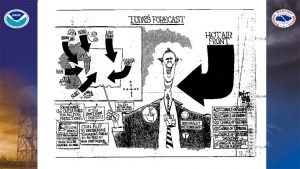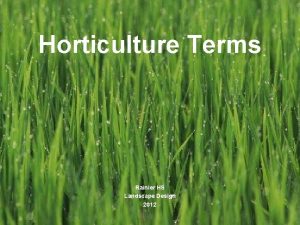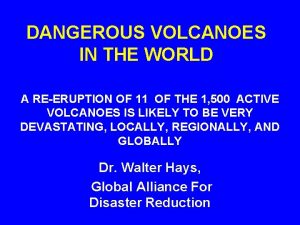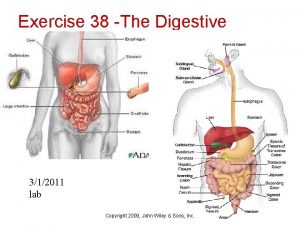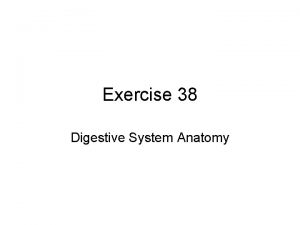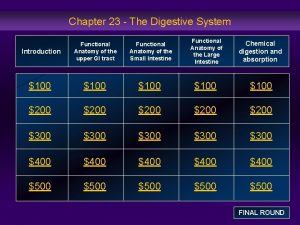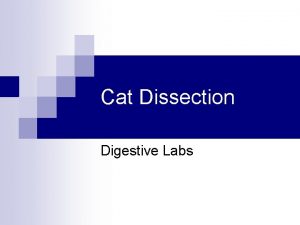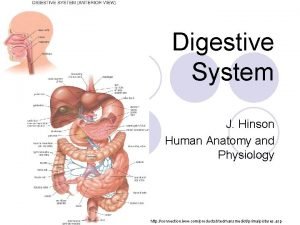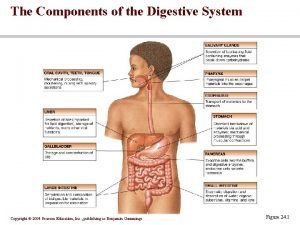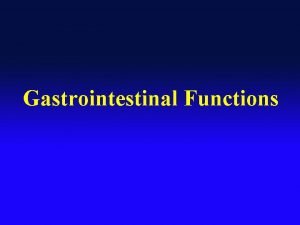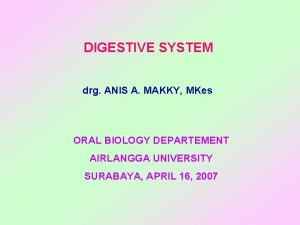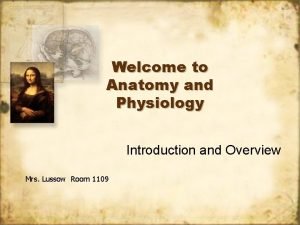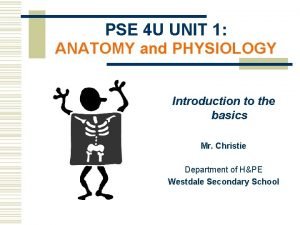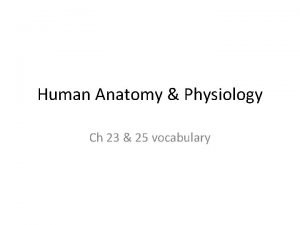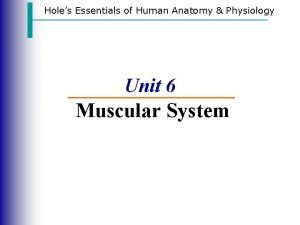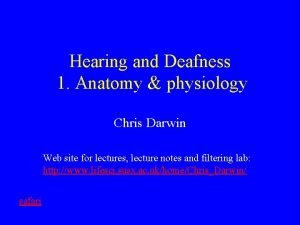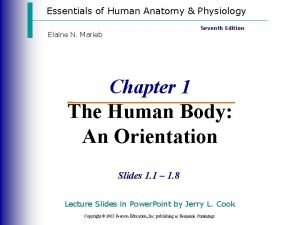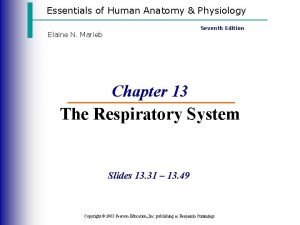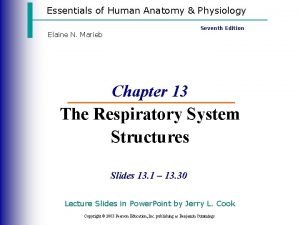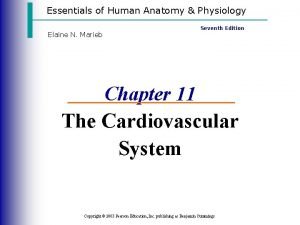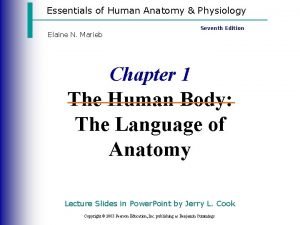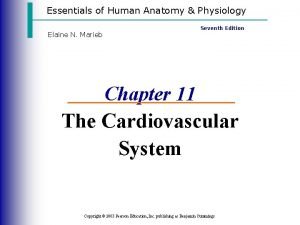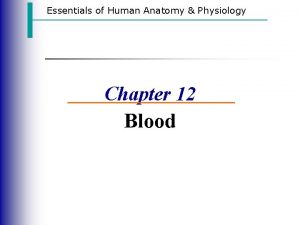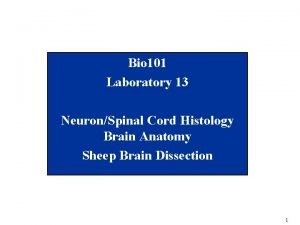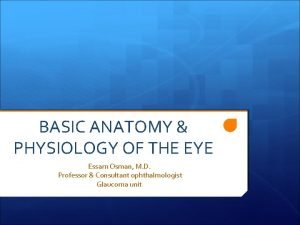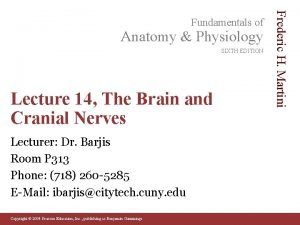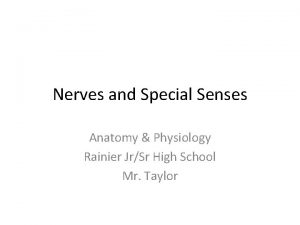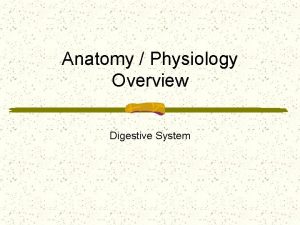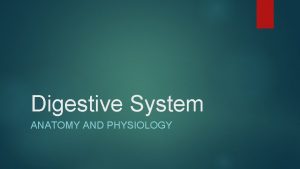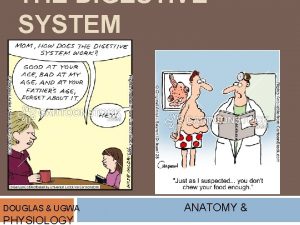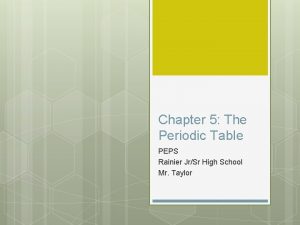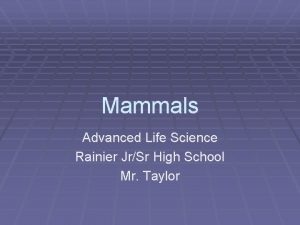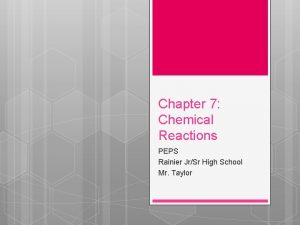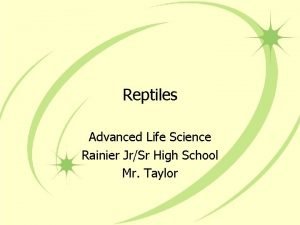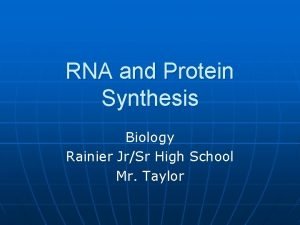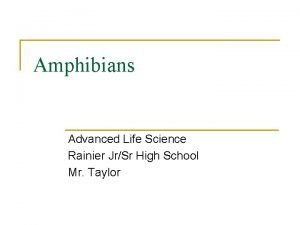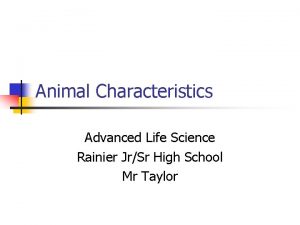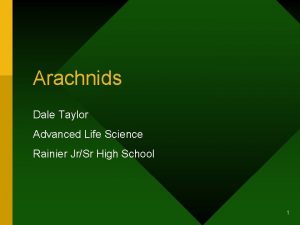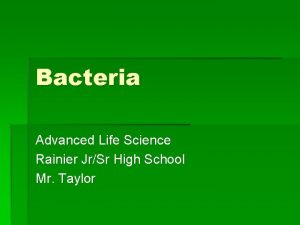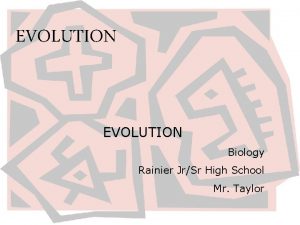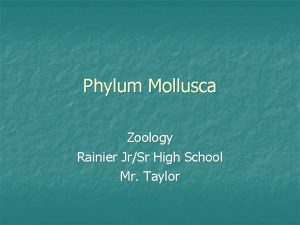Digestive System Part 2 Anatomy Physiology Rainier JrSr

















































































- Slides: 81

Digestive System: Part 2 Anatomy & Physiology Rainier Jr/Sr High School Mr Taylor

Stomach Anatomy n n Rugae – internal folds of the mucosa External regions n n Lesser curvature Greater curvature

Stomach Anatomy Figure 14. 4 a

Stomach Functions n n Acts as a storage tank for food Site of food breakdown Chemical breakdown of protein begins Delivers chyme (processed food) to the small intestine

Specialized Mucosa of the Stomach n Simple columnar epithelium n n n Mucous neck cells – produce a sticky alkaline mucus Gastric glands – secrete gastric juice Chief cells – produce protein-digesting enzymes (pepsinogens) Parietal cells – produce hydrochloric acid Endocrine cells – produce gastrin

Structure of the Stomach Mucosa n n Gastric pits formed by folded mucosa Glands and specialized cells are in the gastric gland region

Structure of the Stomach Mucosa Figure 14. 4 b–c

Food Breakdown in the Stomach n n Gastric juice is regulated by neural and hormonal factors Presence of food or falling p. H causes the release of gastrin Gastrin causes stomach glands to produce protein-digesting enzymes Hydrochloric acid makes the stomach contents very acidic

Necessity of an Extremely Acid Environment in the Stomach n n Activates pepsinogen to pepsin for protein digestion Provides a hostile environment for microorganisms

Digestion and Absorption in the Stomach n Protein digestion enzymes n n n Pepsin – an active protein digesting enzyme Rennin – works on digesting milk protein The only absorption that occurs in the stomach is of alcohol and aspirin

Propulsion in the Stomach n n Food must first be well mixed Rippling peristalsis occurs in the lower stomach Figure 14. 15

Propulsion in the Stomach n n The pylorus meters out chyme into the small intestine (30 ml at a time) The stomach empties in four to six hours Figure 14. 15

Small Intestine n n The body’s major digestive organ Site of nutrient absorption into the blood Muscular tube extending form the pyloric sphincter to the ileocecal valve Suspended from the posterior abdominal wall by the mesentery

Subdivisions of the Small Intestine n Duodenum n n n Jejunum n n Attached to the stomach Curves around the head of the pancreas Attaches anteriorly to the duodenum Ileum n Extends from jejunum to large intestine

Chemical Digestion in the Small Intestine n Source of enzymes that are mixed with chyme n n n Intestinal cells Pancreas Liver n Bile enters from the gall bladder

Chemical Digestion in the Small Intestine Figure 14. 6

Folds of the Small Intestine n n Called circular folds or plicae circulares These are deep folds of the mucosa and submucosa and do not disappear when filled with food The submucosa has Peyer’s patches (collections of lymphatic tissue) These increase the surface area approximately 3 X

Villi of the Small Intestine n n Fingerlike structures formed by the mucosa Give the small intestine more surface area (Approximately 10 X increase) Figure 14. 7 a

Microvilli of the Small Intestine n n n Small projections of the plasma membrane Found on absorptive cells Often referred to as the “brush border”. Increases surface area approximately 20 X An estimate of the total surface area available in the small intestine is 250 m 2. . . or two volleyball courts. Figure 14. 7 c

Digestion in the Small Intestine n Enzymes from the brush border n n n Break double sugars into simple sugars Complete some protein digestion Pancreatic enzymes play the major digestive function n n Help complete digestion of starch (pancreatic amylase) Carry out about half of all protein digestion (trypsin, etc. )

Digestion in the Small Intestine n Pancreatic enzymes play the major digestive function (continued) n n n Responsible for fat digestion (lipase) Digest nucleic acids (nucleases) Alkaline content neutralizes acidic chyme

Absorption in the Small Intestine n n Water is absorbed along the length of the small intestine End products of digestion n Most substances are absorbed by active transport through cell membranes Lipids are absorbed by diffusion Substances are transported to the liver by the hepatic portal vein or lymph

Propulsion in the Small Intestine n n Peristalsis is the major means of moving food Segmental movements n n Mix chyme with digestive juices Aid in propelling food

Large Intestine n n Larger in diameter, but shorter than the small intestine Frames the internal abdomen

Large Intestine Figure 14. 8

Functions of the Large Intestine n n Absorption of water Eliminates indigestible food from the body as feces Does not participate in digestion of food Goblet cells produce mucus to act as a lubricant

Structures of the Large Intestine n n Cecum – saclike first part of the large intestine Appendix n n Accumulation of lymphatic tissue that sometimes becomes inflamed (appendicitis) Hangs from the cecum

Structures of the Large Intestine n Colon n n n Ascending Transverse Descending S-shaped sigmoidal Rectum Anus – external body opening

Modifications to the Muscularis Externa in the Large Intestine n n n Smooth muscle is reduced to three bands (teniae coli) Muscle bands have some degree of tone Walls are formed into pocketlike sacs called haustra

Food Breakdown and Absorption in the Large Intestine n n No digestive enzymes are produced Resident bacteria digest remaining nutrients n n Produce some vitamin K and B Release gases Water and vitamins K and B are absorbed Remaining materials are eliminated via feces

Propulsion in the Large Intestine n n Sluggish peristalsis Mass movements n n n Slow, powerful movements Occur three to four times per day Presence of feces in the rectum causes a defecation reflex n n Internal anal sphincter is relaxed Defecation occurs with relaxation of the voluntary (external) anal sphincter

Accessory Digestive Organs n n n Salivary glands Teeth Pancreas Liver Gall bladder

Salivary Glands n Saliva-producing glands n Parotid glands – located anterior to ears n n Submandibular glands n n 30% of saliva: mostly serous (watery) 60% of saliva: serous and mucus Sublingual glands n 5% of saliva: mostly mucus

Saliva n n n Mixture of mucus and serous fluids Helps to form a food bolus Contains salivary amylase to begin starch digestion and salivary lipase to begin digestion of fats. Dissolves chemicals so they can be tasted. HCO 3– to buffer p. H. Lysosymes to kill bacteria

Teeth n n The role is to masticate (chew) food Humans have two sets of teeth n n Deciduous (baby or milk) teeth 20 teeth are fully formed by age two

Teeth n Permanent teeth n n Replace deciduous teeth beginning between the ages of 6 to 12 A full set is 32 teeth, but some people do not have wisdom teeth

Classification of Teeth n n Incisors Canines Premolars Molars

Figure 14. 9

Regions of a Tooth n Crown – exposed part n n Outer enamel Dentin Pulp cavity Neck n n Region in contact with the gum Connects crown to root

Regions of a Tooth n Root n n Periodontal membrane attached to the bone Root canal carrying blood vessels and nerves

Pancreas Produces a wide spectrum of digestive enzymes that break down all categories of food n Enzymes are secreted into the duodenum n Alkaline fluid introduced with enzymes neutralizes acidic chyme n Endocrine products of pancreas n n n Insulin Glucagon

Stimulation of the Release of Pancreatic Juice n n Vagus nerve Local hormones n n Secretin Cholecystokinin

Liver n n Largest gland in the body Located on the right side of the body under the diaphragm Consists of four lobes suspended from the diaphragm and abdominal wall by the falciform ligament Connected to the gall bladder via the common hepatic duct

Liver functions n Storage and filtration of blood n n 10% of blood volume in liver All blood from intestines goes to liver where 99% of bacteria are removed (as are a lot of other things) Production of bile. Storage of vitamins and iron

Role of the Liver in Metabolism n Many metabolic functions, such as … n n Detoxifies drugs and alcohol Degrades hormones Produce cholesterol and blood proteins (albumin and clotting proteins) Plays a central role in basal metabolism …

Metabolic Functions of the Liver n Glycogenesis n n n Glycogenolysis n n Glucose molecules are converted to glycogen Glycogen molecules are stored in the liver Glucose is released from the liver after conversion from glycogen Gluconeogenesis n Glucose is produced from fats and proteins

Metabolic Functions of the Liver Figure 14. 21

Metabolic Functions of the Liver n Fats and fatty acids are picked up by the liver n n Some are oxidized to provide energy for liver cells The rest are broken down into simpler compounds and released into the blood

Cholesterol Metabolism n n Most cholesterol is produced in the liver and is not from diet Functions of cholesterol n n Serves as a structural basis of steroid hormones and vitamin D Is a major building block of plasma membranes

Cholesterol Transport n n Cholesterol and fatty acids cannot freely circulate in the bloodstream They are transported by lipoproteins (lipid-protein complexes) n n Low-density lipoproteins (LDLs) transport to body cells (“bad” cholesterol). High-density lipoproteins (HDLs) transport from body cells to the liver (“good” cholesterol).

Bile n n Produced by cells in the liver Composition n n n Bile salts Bile pigment (mostly bilirubin from the breakdown of hemoglobin) Cholesterol Phospholipids Electrolytes The function of bile is to emulsify fats.

Gall Bladder n n Sac found in hollow fossa of liver Stores bile from the liver by way of the cystic duct Bile is introduced into the duodenum in the presence of fatty food Gallstones can cause blockages

Nutrition n n Nutrient – substance used by the body for growth, maintenance, and repair Categories of nutrients n n n Carbohydrates Lipids Proteins Vitamins Mineral Water

Dietary Sources of Major Nutrients n Carbohydrates n n n Most are derived from plants Exceptions: lactose from milk and small amounts of glycogens from meats Lipids n n n Saturated fats from animal products Unsaturated fats from nuts, seeds, and vegetable oils Cholesterol from egg yolk, meats, and milk products

Dietary Sources of Major Nutrients n Proteins n Complete proteins – contain all essential amino acids n n n Most are from animal products Legumes and beans also have proteins, but are incomplete Vitamins n n Most vitamins are used as cofactors and act with enzymes Found in all major food groups

Dietary Sources of Major Nutrients n Minerals n n Play many roles in the body Most mineral-rich foods are vegetables, legumes, milk, and some meats

Metabolism n Chemical reactions necessary to maintain life n n n Catabolism – substances are broken down to simpler substances Anabolism – larger molecules are built from smaller ones Energy is released during catabolism

Carbohydrate Metabolism n n The body’s preferred source to produce cellular energy (ATP) Glucose (blood sugar) is the major breakdown product and fuel to make ATP Figure 14. 17

Cellular Respiration n n Oxygen-using events take place within the cell to create ATP from ADP Carbon leaves cells as carbon dioxide (CO 2) Hydrogen atoms are combined with oxygen to form water Energy produced by these reactions adds a phosphorus to ADP to produce ATP can be broken down to release energy for cellular use

Metabolic Pathways Involved in Cellular Respiration n n Glycolysis – energizes a glucose molecule and it is split into two pyruvic acid molecules and yields 2 ATP Pyruvate undergoes hydrolysis to release CO 2, attaches to Co-Enzyme A to form Acetyl Co-A that enters the Krebs Cycle.

Metabolic Pathways Involved in Cellular Respiration Figure 14. 18

Metabolic Pathways Involved in Cellular Respiration n Krebs cycle n n n Produces virtually all the carbon dioxide and water resulting from cell respiration Yields a small amount of ATP Yields 3 molecules of NADH and a molecule of FADH 2 (Basically carriers for energized Hydrogen atoms)

Metabolic Pathways Involved in Cellular Respiration n Electron transport chain n Hydrogen atoms removed during glycolysis and the Krebs cycle are delivered to protein carriers Figure 14. 19 a

Metabolic Pathways Involved in Cellular Respiration n Electron transport chain (continued) n Hydrogen is split into hydrogen ions and electrons in the mitochondria Figure 14. 19 a

Metabolic Pathways Involved in Cellular Respiration n Electron transport chain (continued) n Electrons give off energy in a series of steps to enable the production of ATP Figure 14. 19 a

Fat Metabolism n Handled mostly by the liver n n Use some fats to make ATP Synthesize lipoproteins, thromboplastin, and cholesterol Release breakdown products to the blood Body cells remove fat and cholesterol to build membranes and steroid hormones

Use of Fats for ATP Synthesis n n Fats must first be broken down to acetic acid (a 2 -Carbon molecule), combines with Co-Enzyme A to form Acetyl Co-A. Within mitochondria, acetyl Co-A is completely oxidized to produce water, carbon dioxide, and ATP

Protein Metabolism n n Proteins are conserved by body cells because they are used for most cellular structures Ingested proteins are broken down to amino acids

Protein Metabolism n Cells remove amino acids to build proteins n n Synthesized proteins are actively transported across cell membranes Amino acids are used to make ATP only when proteins are overabundant or there is a shortage of other sources

Production of ATP from Protein n Amine groups are removed from proteins as ammonia The rest of the protein molecule enters the Krebs cycle in mitochondria The liver converts harmful ammonia to urea which can be eliminated in urine

Body Energy Balance n Energy intake = total energy output (heat + work + energy storage) n n Energy intake is liberated during food oxidation Energy output n n Heat is usually about 60% Storage energy is in the form of fat or glycogen

Regulation of Food Intake n Body weight is usually relatively stable n n Energy intake and output remain about equal Mechanisms that may regulate food intake n n Levels of nutrients in the blood Hormones Body temperature Psychological factors

Metabolic Rate and Body Heat Production n n Basic metabolic rate (BMR) – amount of heat produced by the body per unit of time at rest Factors that influence BMR n n Surface area – small body usually has higher BMR Gender – males tend to have higher BMR

Metabolic Rate and Body Heat Production n Factors that influence BMR (continued) n n Age – children and adolescents have a higher BMR The amount of thyroxine produced is the most important control factor n More thyroxine means higher metabolic rate

Total Metabolic Rate (TMR) n n n Total amount of kilocalories the body must consume to fuel ongoing activities TMR increases with an increase in body activity TMR must equal calories consumed to maintain homeostasis and maintain a constant weight

Body Temperature Regulation n n Most energy is released as foods are oxidized Most energy escapes as heat

Body Temperature Regulation n The body has a narrow range of homeostatic temperature n n Must remain between 35. 6° to 37. 8°C (96° to 100° F) The body’s thermostat is in the hypothalamus n Initiates heat-loss or heat-promoting mechanisms

Heat Promoting Mechanisms n Vasoconstriction of blood vessels n n Blood is rerouted to deeper, more vital body organs Shivering – contraction of muscles produces heat

Heat Loss Mechanisms n Heat loss from the skin via radiation and evaporation n n Skin blood vessels and capillaries are flushed with warm blood Evaporation of perspiration cools the skin

Developmental Aspects of the Digestive System n n n Teething begins around age six months Metabolism decreases with old age Middle age digestive problems n n Ulcers Gall bladder problems

Developmental Aspects of the Digestive System n Activity of digestive tract in old age n n n Fewer digestive juices Peristalsis slows Diverticulosis and cancer are more common
 Mt rainier recreational forecast
Mt rainier recreational forecast Rainier landscape design
Rainier landscape design Mt rainier eruption simulation
Mt rainier eruption simulation Anatomy and physiology unit 7 cardiovascular system
Anatomy and physiology unit 7 cardiovascular system Nostrils
Nostrils Appendicular skeleton pectoral girdle
Appendicular skeleton pectoral girdle Copyright
Copyright Exercise 38 anatomy of the digestive system
Exercise 38 anatomy of the digestive system Functional anatomy of the digestive system
Functional anatomy of the digestive system Left common carotid artery
Left common carotid artery Mucus c
Mucus c Intestine
Intestine Protein absorption
Protein absorption Digestive physiology ppt
Digestive physiology ppt Respiratory digestive and circulatory system
Respiratory digestive and circulatory system Upper lower airway
Upper lower airway Tattoo anatomy and physiology
Tattoo anatomy and physiology Science olympiad anatomy and physiology
Science olympiad anatomy and physiology Structure anatomy and physiology in agriculture
Structure anatomy and physiology in agriculture Anatomy and physiology bone
Anatomy and physiology bone Anatomy and physiology of peptic ulcer ppt
Anatomy and physiology of peptic ulcer ppt Liver hilus
Liver hilus Difference between anatomy and physiology
Difference between anatomy and physiology Wpigastric region
Wpigastric region Google
Google The central sulcus divides which two lobes? (figure 14-13)
The central sulcus divides which two lobes? (figure 14-13) 3 layers of muscle
3 layers of muscle Http://anatomy and physiology
Http://anatomy and physiology Chapter 1 introduction to human anatomy and physiology
Chapter 1 introduction to human anatomy and physiology Anatomy and physiology of appendicitis
Anatomy and physiology of appendicitis Aohs foundations of anatomy and physiology 1
Aohs foundations of anatomy and physiology 1 Aohs foundations of anatomy and physiology 1
Aohs foundations of anatomy and physiology 1 Anatomical planes
Anatomical planes Anatomy and physiology chapter 8 special senses
Anatomy and physiology chapter 8 special senses Chapter 13 anatomy and physiology of pregnancy
Chapter 13 anatomy and physiology of pregnancy Teks anatomy and physiology
Teks anatomy and physiology Science olympiad forensics cheat sheet
Science olympiad forensics cheat sheet Chapter 2 basic chemistry anatomy and physiology
Chapter 2 basic chemistry anatomy and physiology Anatomy and physiology of stomach ppt
Anatomy and physiology of stomach ppt Anatomy and physiology diabetes
Anatomy and physiology diabetes Chapter 7 anatomy and physiology
Chapter 7 anatomy and physiology Anatomy and physiology coloring workbook chapter 14
Anatomy and physiology coloring workbook chapter 14 Chapter 10 blood anatomy and physiology
Chapter 10 blood anatomy and physiology Aohs foundations of anatomy and physiology 1
Aohs foundations of anatomy and physiology 1 Aohs foundations of anatomy and physiology 1
Aohs foundations of anatomy and physiology 1 What produces bile
What produces bile Anatomy and physiology chapter 15
Anatomy and physiology chapter 15 Cornell notes for anatomy and physiology
Cornell notes for anatomy and physiology Anatomy and physiology ninth edition
Anatomy and physiology ninth edition Necessary life functions anatomy and physiology
Necessary life functions anatomy and physiology Holes anatomy and physiology chapter 1
Holes anatomy and physiology chapter 1 Holes essential of human anatomy and physiology
Holes essential of human anatomy and physiology Gi tract histology
Gi tract histology Anatomy and physiology
Anatomy and physiology Chapter 1 introduction to anatomy and physiology
Chapter 1 introduction to anatomy and physiology The speed at which the body consumes energy
The speed at which the body consumes energy Aohs foundations of anatomy and physiology 1
Aohs foundations of anatomy and physiology 1 Olecranal region
Olecranal region Human physiology exam 1
Human physiology exam 1 Welcome to anatomy and physiology
Welcome to anatomy and physiology Physiology of the foot and ankle
Physiology of the foot and ankle Skin cancer
Skin cancer Pse 4
Pse 4 Pancreas histology slide
Pancreas histology slide Anatomy and physiology vocabulary
Anatomy and physiology vocabulary Anatomy and physiology
Anatomy and physiology Anatomy and physiology
Anatomy and physiology Anatomy and physiology
Anatomy and physiology Anatomy and physiology
Anatomy and physiology Anatomy and physiology
Anatomy and physiology Anatomy and physiology
Anatomy and physiology Anatomy and physiology
Anatomy and physiology Dorsifelxion
Dorsifelxion Anatomy and physiology
Anatomy and physiology Anatomy and physiology
Anatomy and physiology Anatomy and physiology
Anatomy and physiology Figure 10-1 blood
Figure 10-1 blood Chapter 2 human reproductive anatomy and physiology
Chapter 2 human reproductive anatomy and physiology Paratubular cyst
Paratubular cyst Sheep brain
Sheep brain Anatomy and physiology of the eye
Anatomy and physiology of the eye Cranial nuclei
Cranial nuclei
